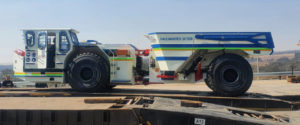Back in August 2020, Polymetal announced that it and underground equipment supplier, Hamm, Germany-headquartered SMT Scharf, had agreed to cooperate in development, implementation and testing of zero-emission battery electric vehicles (BEVs). Initially, the collaboration is focused on mid-ranged LHDs and trucks, with potential involvement of drill rigs and utility vehicles in the future. Two pairs of units (LHD and truck) are set to be tested at Polymetal gold mining operations during a one-year trial with further collaborative re-design, signing of distribution agreement and establishment of after-sales support centre.
The machines, which include the HAULMASTER 30 TEB underground truck and MUCKMASTER 600 EB loader, were duly shipped by August 2021 from Scharf’s new manufacturing hub in Johannesburg, South Africa. Polymetal is evaluating BEVs as part of its exploration of possible avenues to cut greenhouse emissions in the underground mining environment, improve working conditions, plus make long-term cost savings as well as increasing equipment productivity.

SMT Scharf’s Stefan Meyer, Regional Manager for China/Australia/Oceania argues that although the initial capital expenditure is more compared to a diesel equivalent, the long-term operating costs of BEVs are significantly less due to fuel costs, maintenance services and down-time losses “Recent changes in regulation obligate mining companies to reduce greenhouse gas emissions and improve working conditions in underground environments in which they have operations. Conveniently, advances in electric vehicle technology have made converting a fleet of vehicles from diesel driven to electric to achieve these two critical objectives an attractive proposition. This is evident from results of a project which Scharf is currently implementing.”
SMT Scharf’s CEO, Joachim Theiss, is keen to share with global underground mine operators potential opportunities in the deployment of BEV’s in underground mines. “Typically, a lot of work goes in the design to render features that make the electric vehicle suitable for the underground mining environment. Thereafter, the vehicles undergo rigorous testing prior to being delivered to clients.”
The company says its BEVs are designed by experienced mechanical, electrical and hydraulic engineers in accordance with up-to-date ISO mining equipment standards and global best practice. “Steel work (chassis, cabin and dump frames) are designed and manufactured using certified materials and constructed by reputable suppliers. All mechanical, hydraulic and electrical components are carefully chosen from only the best suppliers and assembled using stringent quality control procedures.”
Proven alternatives to conventional-diesel powered vehicles
SMT Scharf observes that BEVs have emerged as capable alternatives to conventional diesel-powered vehicles in terms of performance and environmental compliance (reducing greenhouse emissions) due to the following features:
- Battery equipment does not emit greenhouse gasses during operation;
- BEVs have better performance capabilities due to the advantageous torque curves of electrical motors, which allows for improved tractive effort;
- Battery-electrical motor systems are far more energy efficient than fuel/ICE systems, reducing the generated heat within confined mining spaces. This drastically reduces the ventilation requirements;
- BEVs have less vibration and noise, which improves operator comfort; and
- BEVs incorporate energy regeneration brake systems to charge the batteries when driving down declines.
The company also advises mine operators to take a long-term view when considering adopting battery-powered vehicles as part of their fleet in the underground mining environments. “The ventilation cost saving is the largest benefit when migrating to a battery powered fleet. Ever increasing diesel emission regulations result in more expensive mine ventilation requirements, an issue that BEV’s can completely solve.”


